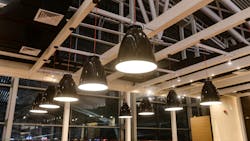As your career advances, it’s crucial that you understand how to properly perform basic branch-circuit calculations and select appropriately sized branch-circuit conductors. You must also know how to size service feeder conductors and overcurrent protective devices (read my last column, “Introduction to Residential Service Calculations,” for more information). These skills are necessary when you start performing commercial service calculations.
Terms you should know
The NEC refers to “nonresidential” commercial buildings and facilities as “other than” in several Articles, which may also include guidelines for residential buildings (i.e., dwelling units). In addition, commercial buildings and hazardous locations are classified in the NEC as “special occupancies.” These include, but are not limited to, churches, nightclubs, warehouses, supermarkets, restaurants, automotive shops, distribution centers, bowling alleys, manufacturing facilities, shopping centers, banks, office buildings, and schools.
When performing commercial service calculations, you’ll be working with motors, lighting systems, HVAC equipment, refrigeration equipment, signage and outline lighting, fixed multi-outlet assemblies, and commercial cooking equipment.
Continuous loads cause heat
Electricians installing branch circuits in retail businesses and commercial facilities are required to designate branch circuits that operate for three hours or more as “continuous loads.” This includes lighting circuits that may serve office areas or public shared spaces. As a result, the branch-circuit conductors, feeders, and the overcurrent protective devices (OCPDs) will need to be rated for higher loads because of the duration that the load is operating; this generates heat on conductors, service equipment, and the circuit breakers.
To compensate for the heat generated by this effect, the electrician must increase the size of the conductor feeding the circuit. As per Sec. 210.19(A)(1), a branch circuit that serves “any combination of continuous and noncontinuous loads, the minimum branch-circuit conductor size shall have an allowable ampacity not less than the noncontinuous load plus 125% of the continuous load.”
Rules in action
Let’s run through a hypothetical scenario to show you how to put these rules into action by exploring an example of a typical master electrician license exam question for a commercial facility.
Situation: The lighting load for an assembly hall with an area of 2,000 sq ft is served with a 120/240V, single-phase panel; no other electrical loads are served from this panel. The lighting load is continuous, and the load is balanced and at the minimum required for the load as specified by the NEC. Calculate the neutral load in amperes.
A. 8.3A
B. 10.4A
C. 16.6A
D. 20.8A
Solution:
Step 1. Find the minimum amount of power we should allocate to lighting. Refer to Table 220.12 General Lighting Loads by Occupancy. This table gives us the required minimum lighting load for specified occupancies. It also helps us determine the number of branch circuits for “general illumination.” Note: On the job site, the numbers used might be higher, so remember this is only the minimum amount required.
Step 2. Find your specified occupancy on the list; we’re looking for an “assembly hall.” Based on Table 220.12, we are required to have a minimum of 1 volt-ampere of power per square foot for this type of occupancy.
Step 3. Multiply the square footage of the building (2,000 sq ft) by the required volt-amperes per square foot (2,000 x 1 volt-ampere = 2,000 volt-amperes). Remember, this is only the minimum that the Code requires to allocate for lighting. It’s only the baseline number.
Step 4. Because the load is continuous, we must increase the capacity of the branch-circuit conductors and circuit breaker/OCPD serving the load. We increase it by 125% because it is “continuous.” See Art. 100 [Definitions] for the meaning of this term. Based on Sec. 210.19 (A)(1), we must increase the load by 125% to compensate for the heat generated during its continuous operation. Here’s the math: 2,000 volt-amperes x 1.25 = 2,500 volt-amperes.
Step 5. Now we need to convert volt-amperes to amperes.
- The lighting load for this assembly hall is served with a 120/240V, single-phase panel, and no other electrical loads are served from this panel, so don’t add anything else in — and don’t get creative.
- The load is also balanced across both phases of the panel. Always use the system voltage when calculating a load across both stages of the service panel. In this case, it’s 240V.
Therefore, the solution is: 2,500 volt-amperes ÷ 240V = 10.4 amperes.
For more assistance on navigating your way through Code requirements, read “The NEC for Newbies.”
Harold De Loach, a master electrician and electrical trainer/instructor, is the founder of The Academy of Industrial Arts (www.taia-school.com) in Philadelphia. With more than 30 years of experience in the field, he writes regular exclusive content for the E-Train and can be reached at [email protected].
About the Author
Harold De Loach
De Loach is the Director of Education and Training for the Leaders of Electrical License Preparation courses for Philadelphia and The Lehigh Valley (www.necprepclass.com). He is the founder and Director of The Academy of Industrial Arts L.L.C. (www.taia-school.com), a customized electrician training program that provides entry-level electrician training courses, electrical safety classes and customized electrical construction courses. He is trained by the National Center for Construction Education and Research (NCCER). He is a member of The National Society of Collegiate Scholars, the Independent Association of Electrical Inspectors, the Electrical Association of Philadelphia, and the Better Business Bureau.
His level of knowledge affords him to teach entry, intermediate, and master level electricians. Armed with more than 20 years of experience in the electrical, general construction, and real estate development industry, he offers his students and clients several unique skill sets. He has worked as the Head Craft Instructor and Assistant Director of Education at the Apprenticeship Training Center (affectionately known as The ABC School) in Harleysville Pennsylvania for Associated Builders and Contractors (The South-Eastern Pa. Chapter). Prior to Joining ABC, he directed a work-readiness (Re-Entry) Construction Technology program within The Philadelphia Prison System and as an Electrical Technician Program instructor at Kaplan Career Institute (Formerly Thompson institute) in Center City Philadelphia and Franklin Mills. He is available for consultation, private tutoring, speaking engagements, or strategic partnerships that can bolster the number of new electricians entering the industry.



